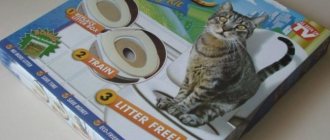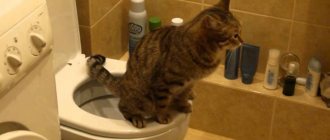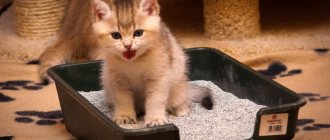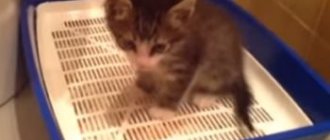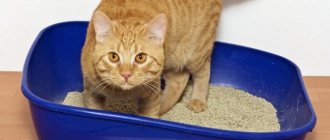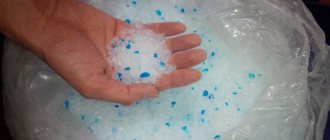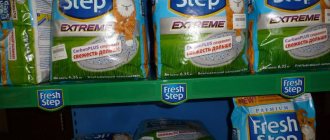Share on social media networks:
The problem of disposing of cat litter is a real headache for owners of mustachioed and striped pets. Naturally, the most convenient option is to flush the used material down the toilet rather than collecting it in a bag and then throwing it away. Some manufacturers of such products indicate that the filler can be disposed of by disposing of it down the drain. However, in reality the picture is far from so rosy. If you throw a large amount of any filler into the toilet, it can cause a blockage. It turns out that instead of saving effort and time, we get a rather serious problem, the resolution of which will take a lot of nerves. After reading this article, you will find out which filler can be flushed down the toilet and whether it is worth doing it in principle.
Is it possible to flush cat litter down the toilet: solving the disposal problem in different ways
Flushable cat litter is the dream of many owners. Indeed, it is much more convenient to simply flush the used material down the drain, rather than collecting it in bags and throwing it into the garbage chute.
However, the reality is a little different: large amounts of any cat litter getting into the pipes can cause blockages. And instead of saving energy, we will end up with a rather serious problem, the solution of which will have to spend a lot of time. To prevent such developments, you should carefully read the tips given in our article.
The contents of the tray need to go somewhere, and the toilet is not always the best choice
The answer to the question whether wood filler can be flushed down the toilet directly depends on the material from which the filler is made. And although manufacturers of almost all varieties do not recommend using this disposal method, some substances still tolerate rinsing better than others.
Wood pellets in a tray
The most popular types of cat litter include:
- Woody - made from pressed sawdust, sometimes flavoring impregnations are added to the composition. When moisture enters, the wood first delaminates and then begins to clump. Among the main advantages of this material are environmental friendliness, relatively low price, ease of disposal, and absence of toxins. At the same time, the material requires regular replacement, otherwise an unpleasant odor will appear within 4–5 days after fresh filling.
Note! Practice shows that varieties without aromatic impregnation absorb odors best.
Pine and fruit tree shavings already smell pleasant, and when mixed with cat waste products, they do not form a nauseating “cocktail”, which often happens with citrus or fruit flavors.
- Mineral - made on the basis of bentonite clay and other substances with high adsorption capacity (zeolite, vermiculite). It clumps quite well, which makes it easier to remove the used part of the material using a scoop. The main advantage of clay materials is that they can very quickly absorb large amounts of liquid, leaving virtually no odor.
Lump of bentonite granules
- Silica gel is the most modern and practical, and has not displaced other varieties from the market only due to its high cost. Requires replacement every two to three weeks, almost completely binds all odors. However, it should not be used for kittens, since they often chew the granules, which can lead to unpleasant health consequences.
As we noted above, the instructions from the manufacturer of most of these materials recommend disposing of them along with solid household waste. All products of this type are non-toxic, therefore we are not talking about any serious environmental pollution.
Photo of silica gel filler
However, many of us try to save labor by flushing the waste contents of the cat litter down the drain. Let's figure it out, is it possible to do this?
Disposal methods
The material from which the filler is made determines its behavior when in contact with liquid. Accordingly, this directly determines whether the waste will pass through the pipe or get stuck in it, forming a plug.
Small lumps can be easily washed off
You will find the answers to this question in the table:
| Type of filler | Possibility of flushing the toilet |
| Woody |
|
| Mineral |
|
| Silica gel |
|
Soaked sawdust often forms a dense plug
Summarizing all of the above, it should be noted: you should not create problems for yourself by flushing substances not intended for this purpose down the drain. It is better to collect and throw away the contents of the cat litter, or (in the case of woody and mineral varieties) put it in a compost heap.
Methods for removing blockages
Mechanical pipe punching
If trouble does occur, and as a result of a large amount of filler getting into the sewer system, it is necessary to take action.
You can deal with blockages like this:
- If the incident has just happened, and the bulk of the material is in the toilet itself, you need to remove it from there as quickly as possible. To do this, we put a rubber glove on our hand and scoop out everything we can reach.
Advice! If you don't have gloves, you can wrap your hand in a plastic bag.
- After manually cleaning the toilet, you need to push the residue (there should be relatively little of it) into the pipe itself. To do this, install a plunger on the drain hole, press the rubber socket tightly to the surface and begin pumping, as during normal cleaning.
Using a plunger to remove a blockage
- To make the work more efficient, it is advisable to add a small amount of water to the toilet. However, do not overdo it - if the cork is very dense, then you will have to remove the water by scooping it out.
- When sawdust filler gets into the pipes, a plunger should be enough. But bentonite is capable of blocking the lumen “tightly”, so the plug will have to be destroyed mechanically.
- To do this, we use a cable with a special attachment, which we screw into the jam and destroy it. Our goal is to punch a hole in the center of the pipe, and then the flow of water will gradually wash away the contamination.
The spiral tip of the cleaning cable should screw into the blockage relatively easily
Chemical methods
In some cases, the filler does not form a blockage, but simply accumulates in the drain and reduces the throughput of the sewer.
Here you can cope with the situation using chemicals:
This or a similar remedy may also help
- We pour granular powder into the pipes in the most problematic area.
- Add a small amount of water and leave for about 20-30 minutes to react.
- After this, we thoroughly rinse the system, draining the water from the tank several times.
- Acid products are considered the most effective, since they are good at destroying organic matter accumulated in the sewer.
Conclusion
On the one hand, the discussion about whether it is possible to throw cat litter into the toilet does not have a single correct solution: some varieties can be disposed of in this way, and some are better not to be poured into pipes in order to avoid clogging the sewer system. Still, it’s much better to simply collect the waste contents of the tray and throw it in the trash - this way we can be sure that no problems will arise.
The issue raised is discussed in more detail in the video in this article, so cat owners should watch it very carefully.
hydroguru.com
What to do if there is a blockage?
First you need to determine whether water can pass through the pipeline or whether the passage is completely blocked. To do this, pour water into a small container and pour it into the pipe. If liquid leaves the toilet, then there is a passage, and the blockage can be easily removed on your own. If the water remains in place, then most likely the blockage is mechanical, which in most cases can only be removed by a professional plumber.
Tip: Do not press on the tank to check the rate of water drainage. It is designed in such a way that if it starts working, it must drain all the accumulated water. If the pipe is clogged tightly, then water can simply flow through the top of the toilet.
After this, you need to determine where the blockage is located. To do this in the same way, drain water into all pipelines in the apartment or house. Depending on the result of the check, you need to think through an action plan. If liquid flows out normally everywhere, then the problem is only in the toilet, but if it drains slowly in some drain, then there is a reason to fill it with a universal home remedy - soda and vinegar.
Video: How to clean a toilet.
It is very convenient that it is very easy to rinse a small pipe with soda without a plunger. You just need to add a good amount of powder and vinegar. Be careful not to inhale fumes. Then wait 40 minutes and pour hot water over everything. Repeat if necessary. This can be done with the washbasin, but not with the toilet main pipe. It is too large in diameter and this method will not work.
Step-by-step instructions on how to eliminate a mechanical blockage:
Buy a special plumbing cable. It is a wire enclosed in a dense rubber sheath. This device works great if you need to remove a rag, piece of paper, etc. from a pipeline;
Place the cable in the toilet and gradually begin to push it inside
It is very important to rotate it all the time so that it follows the bends of the pipe; As soon as the tip of the device touches an obstacle, check that it is not a pipe wall. And use slow movements to pull out the cause of the blockage.
It is very important to do all work with gloves.
After this, fill the toilet with a special agent for additional cleaning. You need to be careful and, without such experience, do not do this work yourself. If you move incorrectly, you can easily pierce a plastic pipe with the metal hook of the cable.
Sometimes, to remove small blockages, it is enough to use a plunger in the toilet. You need to insert it as deep as possible into the toilet and start pumping out the air. In order to get a rag, this is often enough.
Vantus for clearing blockages
How to eliminate technical blockage:
- The cable is not used here, since the cause of the sewerage breakdown lies in the layers on the walls. You will need to buy a special pipe cleaner. Now in any hardware store and supermarket there is a large list of similar products. For example, “Domestos”, “Mr. Muscle”, “Mole” and others;
- Before use, you must carefully read the instructions. Some types of such products cannot be used on plastic;
- In most cases, the solution is simply poured into the pipeline and left for a certain period of time. During this period, you should not go to the toilet, or even flush it away, otherwise all the work of the product will come to naught;
- When the solvent expires, you need to pour a bucket of hot water into the toilet. High temperature promotes the disintegration of feces on the walls of the sewer and cleaning of the pipeline.
Professional toilet cleaning
If the blockage is serious, then it would be best to buy a product that contains alkali - it will quickly destroy the layers accumulated over the years of sewer service. In order for the listed methods for clearing a clogged toilet to be as effective as possible when such a situation arises, you need to periodically clean the pipeline with special compounds.
Quite often, sewer drains stop doing their job effectively and require repair or cleaning. To do this, you need to know how to remove a clogged toilet at home, without turning to professionals.
Is it possible to flush cat litter down the toilet?
Manufacturers do not recommend throwing cat litter down the toilet, as there is a high probability of clogs in the pipes. However, some granules made from natural materials will not cause plumbing problems if small portions are poured and washed off. The best option for disposing of excrement without the risk of negative consequences is to throw it away together with other waste in a trash container.
Types of filler
It is especially dangerous to flush away used granules in homes with old pipes. Even if no visible plug is formed, the risk of pipe clogging on the lower floors is high.
Pet supply companies have created special cat litters from compressed sawdust, artificial granules and natural adsorbents, such as bentonite, aqueous calcium and sodium aluminosilicates, and hydromica. The products are designed to quickly remove excrement odors and make it easier for your cat to get used to the new litter box. Pet owners especially recommend using granules in cases where the cat stays in the apartment for a long time on its own, and it is not possible to constantly clean the basin. The table shows the best types of litter that can be added to your cat's litter box:
| View | Advantages | Flaws |
| Wood filler | Does not harm the environment | Need for frequent replacement |
| Low cost | ||
| Easy to recycle | Creating dust when falling asleep | |
| No toxic components | ||
| Availability of products with flavors | Getting stuck in animal fur | |
| Silica gel | No need for frequent replacement | High price |
| Completely eliminates odors | Risk of indigestion if your pet ingests the kibble | |
| Mineral granules | Crumples quickly | Need for regular replacement |
| Easy to assemble with a scoop | ||
| Quickly absorbs liquids | Sticking to pets' paws | |
| Eliminates odors well | average cost |
Return to contents
Where should I put the used filler?
Some types of granules can be disposed of in the bathroom in small portions.
Most manufacturers prohibit throwing used granules into the toilet, since the components of the hygiene product quickly swell when they get into the water, and this can lead to blockages and flooding of the lower floors. There have been several cases of litigation due to accidents caused by ill-considered actions of pet cat owners. Filler manufacturing companies recommend the following methods for disposal of waste:
- Placed in a vacuum bag. It is recommended to pack granules that have clumped into lumps and throw them in with the rest of the household waste. If the bag has a zipper, there will be no unpleasant odor in the room.
- Rinse in small portions. The method is suitable for some types of fillers. Lumps must be selected and poured into the toilet, but the volume should be small so that the toilet does not clog.
- Fertilizing plants. Sawdust will have a beneficial effect on the soil, therefore, if a cat lives near a personal plot, you can not throw away the granules, but use them for household needs.
Return to contents
Which one can be washed off?
Silica gel granules should not be thrown into the toilet, as there is a high probability that a plug will form from waste in the pipes, and not in the bathroom itself. It will be impossible to dissolve such a blockage from the apartment and will require lengthy and expensive work by plumbers. It is also not recommended to wash off the mineral filler, but the consequences are less dangerous than when releasing silica gel. Most often, blockages occur in apartments, but this problem can be solved with the help of special chemicals.
If the filler that caused the breakdown is still visible at the bottom of the toilet, you should try to pull it out manually, and only then add special cleaning powders.
Sawdust can be disposed of in the bathroom if the granules have decomposed into fine shavings. But to prevent the toilet from clogging, you should empty out only the formed lump, and not all the litter from the cat's litter box. The only filling that manufacturers always allow to be washed off is paper, but it does not cope well with odors and quickly gets wet.
infokotiki.ru
How to care for a tray with wood filling?
Pour up to 3 cm of filler into a dry tray. Regularly remove solid waste from the tray with a special scoop and once a week completely replace the filler from the tray with a fresh portion. Before filling a new portion of wood filler, we recommend sanitizing the tray.
Interesting materials:
When is the best time to take cuttings from paniculate hydrangea? When is the best time to take juniper cuttings? When is the best time to take petunia cuttings? When is the best time to take thuja cuttings? When is the best time to root thuja cuttings? When is the best time to root pelargonium from cuttings? When is the best time to take thuja cuttings? When is the best time to take thuja cuttings? When is the best time to prepare cuttings for grafting? When can you take begonia cuttings?
What kind of litter can be flushed down the toilet?
The problem of disposing of cat litter is a real headache for owners of mustachioed and striped pets. Naturally, the most convenient option is to flush the used material down the toilet rather than collecting it in a bag and then throwing it away. Some manufacturers of such products indicate that the filler can be disposed of by disposing of it down the drain. However, in reality the picture is far from so rosy. If you throw a large amount of any filler into the toilet, it can cause a blockage. It turns out that instead of saving effort and time, we get a rather serious problem, the resolution of which will take a lot of nerves. After reading this article, you will find out which filler can be flushed down the toilet and whether it is worth doing it in principle.
Classification
There is only one correct answer to the question: “Is it possible to flush cat litter down the toilet?” It all depends on what material the filling is made of. As already mentioned, any type of it can cause problems with the patency of sewer pipes, but some materials tolerate flushing better, while others - worse. Let's take a closer look at the most common options.
Woody
For its production, pressed sawdust is used, sometimes with aromatic impregnations. When moistened, the wood first flakes and then comes together in clumps. The advantages of wood fillers include:
- Relatively low price.
- Ecological cleanliness, absence of substances harmful to health.
- Easy to recycle.
Disadvantages include the need for frequent replacement. If you do not replace the litter box in time, then after 4-5 days you will begin to be bothered by unpleasant “odors” from the cat’s litter box.
Important! Practice shows that it is better to buy fillers without flavors. Fruit tree shavings have a natural, pleasant odor and mask stool odors well. Artificial fragrances, on the contrary, form an unbearably sickening “amber” with cat urine. In addition, the smell of citrus fruits repels the animal.
Mineral
The basis of the mineral filler is bentonite clay, as well as other substances with good absorption capacity (vermiculite, zeolite). When wet, the mixture clumps and can be easily removed using a special scoop.
Important! The main advantage of clay materials is that they not only absorb liquid well, but also absorb odors.
Silica gel
This is the most modern and practical option, the only drawback of which is the relatively high cost. You can change such consumables once every 2-3 weeks, there is practically no unpleasant smell. But it is not advisable to use this filler for kittens, since they chew the granules, and this can harm the baby’s health.
Paper
Unfortunately, paper-based filler is rarely found in retail sales. Japanese products are considered the best here. It can be found on the websites of special online stores selling Japanese pet products. There is only one drawback - the high price.
Vegetable
Like paper, vegetable litter (such as corn) can be disposed of down the drain. But, unfortunately, this is where their advantages end. Next come the downsides:
- The filler is lightweight, which means it spreads throughout the apartment.
- Doesn't neutralize odors well (2 days and an unbearable stench).
Important! This option can be used if the pet suffers from allergies to all other types of materials.
A separate type of vegetable fillers is based on soy fiber. Unlike corn, they have excellent performance qualities. The disadvantage is the same as with paper products - high price.
How to dispose of litter, or what kind of cat litter can be flushed down the toilet?
It all depends on how this or that material behaves when in contact with water:
- Wood pellets quickly become wet when in contact with water. If you flush a small amount of sawdust pellets down the toilet, no problems will arise. However, trying to wash off a large amount of filler at once usually ends in failure. The water from the tank is clearly not enough to wash away a lot of sawdust. While water fills the tank, the sawdust has time to compress into a rather heavy plug.
- The mineral filler forms into a dense lump almost instantly. It is for this reason that you should never flush the contents of the tray in the toilet. The exception to the rule is when trying to wash small lumps down the drain. In this case, unpleasant consequences can be avoided. If you decide to pour all the filler from the tray down the drain at once, then a blockage inside the pipe is guaranteed. And destroying it will be quite problematic. Thus, the answer to the question: “Can clumping litter be flushed down the toilet?” - negative.
- Silica gel is used sparingly and absorbs odors perfectly, but problems may arise with the disposal of granules in the toilet. When a large amount of material is poured down the drain, the substance swells. The blockage does not occur in the toilet itself, but in the sewer pipes located below. It will be impossible to remove such a plug.
- Paper filling is perfectly disposed of in the toilet and is one of the most environmentally friendly and safe options. This flushable cat litter is a real boon for lazy owners.
Video material
Thus, there is no need to create difficulties for yourself with your own hands. Substances not intended for this purpose should not be flushed down the drain. Paper and vegetable fillers are the exceptions that prove the rule. Disposing of the filler in a plastic garbage bag will not take much time, and it is not worth taking unnecessary risks.
serviceyard.net
Is it possible to flush cat litter down the toilet?
In some cases, it is difficult to get rid of the used substance. This procedure requires attention and caution. Is it possible to flush cat litter down the toilet? This is acceptable in some situations and depends on the composition of the substance.
What kind of material can be used at home? In some cases, it is better to empty the contents into a bag and take it to a container or garbage disposal. To determine the optimal disposal method, you need to understand the constituent substances that help absorb moisture and odor from cat feces.
Different manufacturers independently determine the quality composition of their products. In pursuit of originality, developers try to keep up with each other and take into account all the needs of pets and their owners. Over time, many options have appeared that differ in composition and properties.
Made of wood
After moisture enters, the absorbent material first delaminates. Woody substances act like a sponge, which does not release accumulated moisture, but turns it into a clumping mass.
Pros:
- The relatively low price makes this type available if there are several pets and more materials are required than when one animal lives in an apartment with its owners.
- Small kittens exposed to strong external factors on their health from woody compounds do not have an allergic reaction.
The downside of this type is its fragility. You will have to take your pet out or flush it down the toilet up to twice a week, otherwise the unbearable smell will spread throughout the apartment and penetrate into the entrance. Conflict with neighbors cannot be avoided.
When choosing a filler, it is recommended to choose a material with a natural odor. A common reason for a kitten’s refusal to go to the toilet on its own is an orange or lemon smell that is barely noticeable to us, but unbearable for a cat.
From paper
Fillers of excellent quality, rarely found on supermarket shelves. It is easier to purchase this type at a pet store that sells Japanese-made products. Easily dissolves in water. The optimal material in all respects is worth the money that traders and resellers ask for it.
Silica gel
More often, similar fillers are found on store shelves. They are no different in cost from paper ones, but such material should be taken out once every few weeks. There is practically no smell from using this substance as cat litter.
From mineral components
This composition is suitable for long-term use, the liquid quickly turns into a lump, preventing the stench from spreading, and helps to quickly clean the tray.
Substances that make up mineral compositions for cat litter:
- bentonite clay;
- zeolite;
- vermiculite
The clay filler adsorbs perfectly and leaves no odor in the apartment.
From plant materials
Substances of natural origin decompose well in water. It will not be difficult to dispose of them using the toilet.
Positive aspects of using corn fillers:
- you can throw it in the toilet;
- Suitable for kittens with allergies to chemicals.
Negative points:
- particles cling to the cat's paws and are dragged around the living space;
- They smell bad after a couple of days.
Soy filling trays:
- They do not stick and have enough weight to remain in place throughout the entire period of use.
- Excellent at retaining unpleasant odors.
Minuses:
- difficult to find in the store;
- the price is several times higher than the average cost of adsorbents for a tray.
In order not to be afraid of stagnation in the sewer, you need to be aware of what fillers can be flushed down the toilet.
These include:
Corn and paper are washed off and do not clog sewer pipes.
Woody ones are easily disposed of at home only in small doses and quickly. If you fall asleep first and press the button a few minutes later, you will have to call a locksmith. Large batches of the substance, which are completely thrown into the toilet, will bring negative consequences a little later. But it will be difficult to get rid of these troubles, since a blockage forms in the pipes.
Silica gel has the same properties in water as wood filler, but the consequences of a silica gel plug deep in the pipe are technically impossible to eliminate. The part must be replaced at the personal expense of the cat owner.
Do not flush mineral fillers down the toilet, as the moment they come into contact with water, the material turns into a stone state. The clog can only be removed from the toilet with the help of a professional. If unsuccessful, you will have to replace part of the sewer with a new one.
Video: Is it possible to flush cat litter down the toilet?
It is unacceptable to allow pollution of the natural and residential environment. There are a number of recommendations for eliminating pet waste.
- You must carefully read the labels on the packages and follow the instructions.
- When choosing a filler, rely not only on the capabilities of your own budget, but also on the inclinations of your household.
- If grandma is used to throwing the contents of the cat litter down the toilet, it is better to try and buy paper or soy litter. It will cost less than repairing sewer pipes.
- If it is not possible to take the plastic bag with wood filler out of the apartment, you should flush several lumps down the toilet every half hour.
- This procedure is not recommended to be carried out too often.
- Wood or clay litter can be placed in the compost pit, mixed with grass. In the future, it is proposed to use the contents as fertilizer for growing fruits on the site.
People say: laziness is the engine of progress. But not in the case of recycling this kind of waste. It will be easier for yourself, your neighbors, your family budget and the cat itself to dispose of standard litter in the usual way, using a garbage chute or a bin in the yard.
For those who want to throw cat waste into the toilet, a litter made of paper and soy fibers is perfect.
ubratdoma.ru
